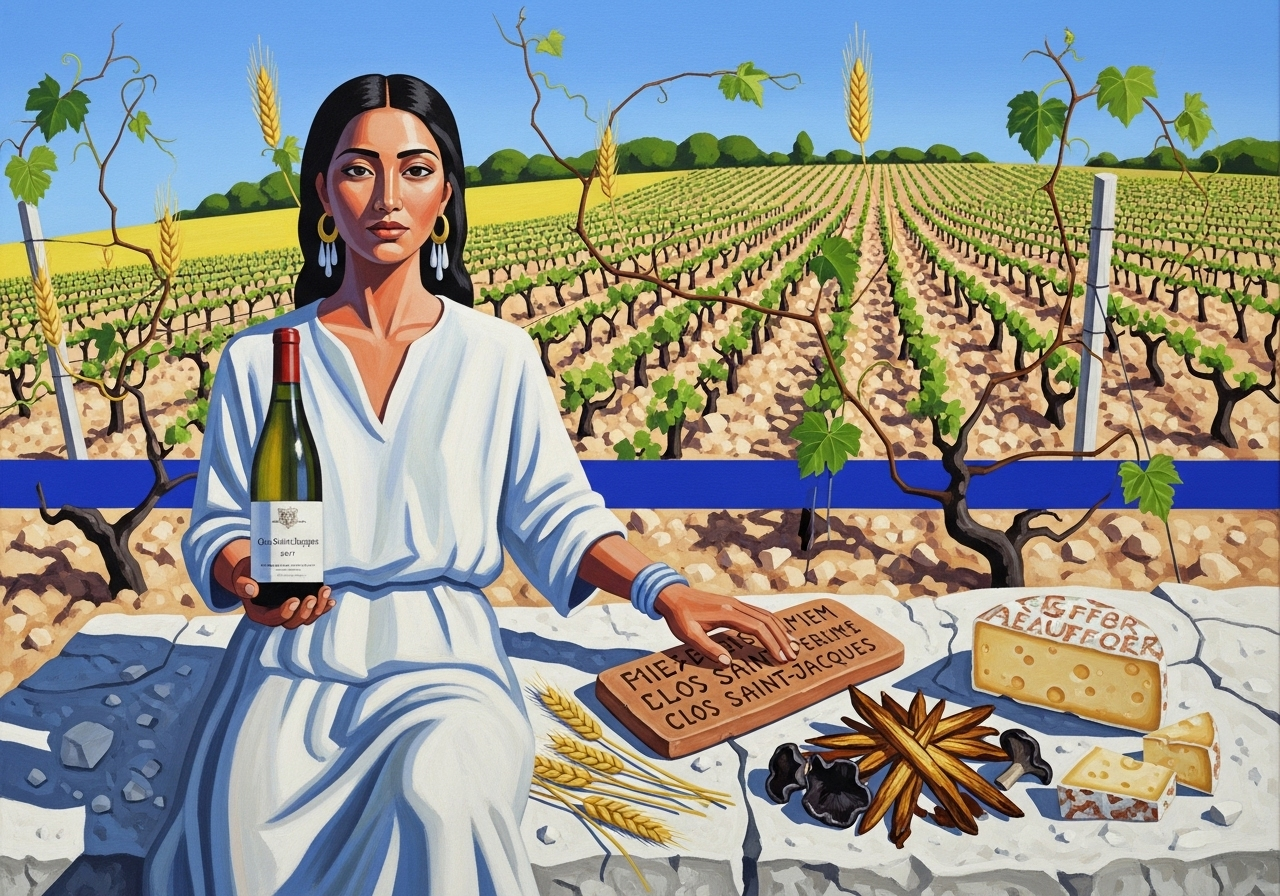Dreams in the Limestone: Domaine Fourrier Clos Saint-Jacques 2017
Explore Domaine Fourrier Clos Saint-Jacques 2017 food pairing with singular dishes from pigeon to celeriac, in a lyrical, terroir-rooted guide.

First Pour: Embers in the Glass
The first pour gleams garnet, translucent yet profound, like embers glowing through an old vineyard wall at dusk. At 16–17 °C the wine speaks in whispers: violets, wild strawberries, the faint smoke of sun-warmed stone. Given an hour in a decanter, its tannins—silken yet insistent—ease into velvet. In a broad Burgundy bowl, the aromas rise like lines of poetry carried on vapor, each verse unfurling with patience. This is not a wine to be hurried; Clos Saint-Jacques must be read like scripture, with reverence for its unfolding.
Written in Soil and Memory
Burgundy’s Côte de Nuits, and Gevrey-Chambertin in particular, is a place where earth and vine conspire to shape voices unlike any other. Clos Saint-Jacques, a Premier Cru whispered of as Grand Cru in all but name, clings to limestone and marl. Domaine Fourrier, guided by Jean-Marie Fourrier, tends its Pinot Noir with devotion bordering on liturgy. Old vines root deeply here, drawing mineral marrow from stone, their vigor tempered by cool nights that sharpen fruit into clarity. From this tension of warmth and chill, fruit and soil, the wine finds its singular timbre.
The Voice of 2017
The 2017 vintage, born of a mercurial spring and a steady summer, gave wines of poise rather than power. In this glass, I find red currant and Morello cherry, rose petals pressed into sunlight, a flicker of orange peel, and the grounding weight of iron-rich soil. Acidity runs through it like a spring, carrying fruit and earth together. The tannins are woven, never coarse; oak is a trace of spice, a frame but not a mask. The finish lingers with stony persistence, as though the vineyard itself has signed the tongue with its autograph.
Fire and Flesh
Such a wine demands companions of equal depth. Saddle of lamb roasted over vine cuttings draws out its wildflower and graphite tones, the charred herbs singing back to its violet perfume. Pigeon breast, seared rare and humming with iron, finds harmony in its earthy undertones. These are dishes of fire and flesh, not generic but elemental, echoing the soil and stone beneath the vines.
Journeys Beyond Burgundy
The wine also travels well beyond its birthplace. Imagine Japanese duck breast, lightly smoked over cherry wood and brushed with soy-honey glaze—the interplay of sweet, salt, and umami mirrors the wine’s red fruit and savory pulse. Or cassoulet Toulousain, a slow-braided symphony of duck confit, sausage, and beans, its richness lifted by the wine’s cleansing brightness. Such pairings are not mere matches but layered harmonies, voices joining in chorus.
Earthly Luxuries
For those who seek the vegetal and the earthen, luxury is found in roots and fungi. A tart of caramelized salsify with black trumpet mushrooms, bound in aged Gruyère, resonates with the wine’s forest-floor register while buttered richness smooths its tannins. Or roasted celeriac glazed in hazelnut butter, its sweetness drawing out red fruit, its nut oils amplifying limestone’s edge. These dishes speak not as substitutes but as true dialogues with the vineyard’s vegetal soul.
The Humble Transformed
Even the humbler table can honor Clos Saint-Jacques. Lentils braised with herbs and smoke carry an earthy heartbeat that folds into its structure. Jerusalem artichokes, roasted until caramel-dark, let their bittersweet edges coax out the wine’s flicker of citrus. These are refrains, quiet yet essential, like the echo in a lament.
No Sweetness, Only Truth
No sugared finale is welcome here. The wine’s dry, tensile frame resists sweetness, refusing to bend toward confection. Instead, close the night with aged Beaufort, its salt and fat aligned with acid and tannin in a final, resonant chord. Such a farewell is more truthful than any dessert: austere, generous, complete.
The Goddess Remembers
As I sip, I remember my half-year beneath the earth, stylus in hand, recording the names of the departed. Like this wine, I too return renewed, carrying both shadow and blossom. To drink Clos Saint-Jacques is to taste descent and return, the silence of stone and the song of spring. The limestone remembers, and so do I.
Closing the Ledger
The 2017 speaks clearly now, yet promises more between 2030 and 2038, its voice deepening with time. Honor it with patience in the decanter, fidelity to temperature, and the broad glass that frees its fragrance. Above all, approach it as you would a dream: reverently, for the vine—like memory—yields more the longer you attend.





